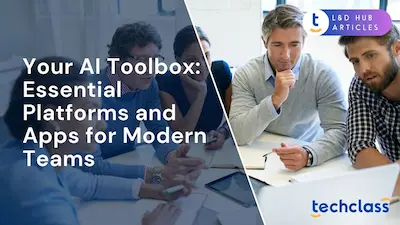
Picture an orchestra performance. Every musician must play from the same sheet of music for the symphony to succeed. If one section is out of sync, the whole piece suffers. Business works in a similar way. Traditionally, corporate learning focused almost entirely on internal employees, ensuring staff were trained to perform their roles effectively. But in today’s interconnected world, companies have realized that their “orchestra” includes more than just employees. Partners, suppliers, distributors, and even customers all play a part in a company’s success. If these external stakeholders aren’t “in tune” with the company’s knowledge and practices, the performance of the business as a whole can falter.
Over the past few decades, corporate learning and development (L&D) has evolved from an inward-facing function to a broader, outward-reaching strategy. The concept of the extended enterprise has now made its way into the learning domain. Extended enterprise learning refers to training not just your employees but also anyone outside your organization who impacts your business, using the same playbook. The goal is to create a unified, informed ecosystem where everyone from channel partners to end customers, shares the knowledge needed to represent and use your products or services effectively.
This article explores how corporate learning has shifted from an internal-only focus to include the entire extended enterprise. We’ll define what extended enterprise learning means, discuss why this shift is happening now, highlight the benefits and challenges of training your broader business network, and outline strategies for implementing an extended enterprise learning program. Along the way, we’ll look at real examples and insights to illustrate this evolution.
For decades, corporate learning and development focused exclusively on a company’s own employees. Organizations invested in programs to onboard staff, develop skills, and ensure compliance, but customers, distributors, and other outsiders received little to no formal training from the company. External groups were largely left to learn on their own through product manuals or ad-hoc support. This inward-looking approach made sense when products were simpler and business boundaries were clearer, but it often led to inconsistencies. A customer might struggle to use a complex product correctly without guidance, or a reseller could misrepresent a service due to limited knowledge. Traditionally, such gaps were not seen as the training department’s concern. Even today, many companies stick to internal training; for example, only a small fraction of organizations currently provide structured learning to their suppliers or channel partners. However, awareness is growing that this model is no longer sufficient in a highly interconnected business environment.
Multiple forces are prompting companies to expand their training programs beyond internal staff. One major driver is the recognition that business success now depends on a whole ecosystem of partners, suppliers, and customers. If these external players lack knowledge or skills, it can directly hurt sales, customer satisfaction, and brand reputation. On the other hand, when partners and clients are well-trained and informed, they become more effective and add value to the business. Additionally, today’s products and services are often complex or highly specialized, which makes external training critical. Customers expect self-service tutorials, certifications, and support materials to help them get the most out of what they buy. Similarly, channel partners need up-to-date product knowledge and sales training to represent offerings correctly. Providing education to all stakeholders can be a key differentiator in a competitive marketplace.
Technology has also made extended enterprise learning both possible and efficient. Modern online learning platforms enable companies to deliver courses and resources to anyone, anywhere, at relatively low cost. This means training no longer stops at the office door; a global network of distributors or users can access the same learning content through a cloud-based system. Another consideration is consistency: organizations want to ensure their brand and standards are upheld across every touchpoint. Training external parties (for instance, franchisees or service vendors) helps ensure they follow the same quality guidelines, safety procedures, and messaging as the internal team.
Crucially, the business case for extended enterprise learning is growing stronger. Research shows that companies who invest in educating their external stakeholders reap tangible benefits. In industry surveys, over half of companies saw reduced training costs and improved customer relationships after extending learning beyond employees, and many also experienced higher customer retention. Notably, these gains were achieved with only a modest allocation of resources, and in many firms training beyond the employee base accounted for less than 10% of the L&D budget. Yet, the impact in terms of customer loyalty, partner performance, and revenue growth was significant. This high return on investment is a big reason why more organizations are now looking outward when it comes to learning and development.
Extended enterprise learning refers to the practice of providing training and educational resources to people outside your organization’s direct workforce. This includes external stakeholders such as customers, dealers, distributors, franchisees, suppliers, or contractors (essentially anyone who uses, sells, or is impacted by your products and services). The aim is to ensure these partners and clients have the knowledge and skills to represent your brand correctly and get maximum value from your offerings. In effect, the company treats its broader business network as part of the learning audience, rather than limiting education to employees. Many companies support this effort with specialized learning management systems that can deliver courses to external users and track their progress. By educating individuals beyond your payroll, you help align your entire ecosystem with the company’s standards, product information, and best practices.
In conclusion, expanding corporate learning to the extended enterprise is becoming a critical strategy in the modern business world. No company operates in a vacuum; success depends on an ecosystem of employees, partners, and customers working in sync. By educating those beyond your organization’s walls, you ensure that everyone who represents or interacts with your brand can do so with competence and confidence. This broader approach to L&D fosters consistency across the board, strengthens business relationships, and ultimately drives better performance outcomes.
Adopting an extended enterprise mindset may require a cultural shift and additional effort, but the payoff is a more agile and aligned network of stakeholders. Organizations that invest in training not only their internal teams but also their external collaborators are positioning themselves for greater customer satisfaction, higher partner productivity, and a true competitive edge. In essence, the evolution from internal-only training to an inclusive learning ecosystem enables a company and its entire community to grow and succeed together.
Extended enterprise learning involves providing training and educational resources to external stakeholders such as customers, partners, suppliers, and contractors to ensure they are aligned with company standards and practices.
Organizations are expanding training to external stakeholders to improve brand consistency, increase customer satisfaction, boost sales, and leverage technology-enabled scalable learning.
Challenges include engaging diverse external audiences, measuring ROI, managing technology and access, and resource constraints related to content development and support.
Key steps include defining goals, securing leadership support, customizing content, choosing the right platform, promoting participation, and continuously monitoring and improving the program.
Benefits include consistent knowledge sharing, higher customer satisfaction, increased sales, stronger partner relationships, and reduced support costs.


.webp)